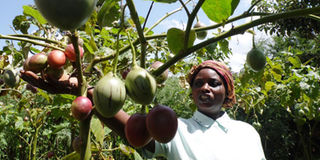Farmers cash in adding value to gooseberry

A gooseberry farmer checks the hybrid crop. File photo.
What you need to know:
- Gooseberry is considered a wild plant however farmers have started growing it for commercial purposes and value addition.
- Farmers – Abbas Were and Fred Matovu explain to Fred Muzaale how they use a solar drier to produce a medicinal product from the berries.
Very few people in Uganda carry out gooseberry growing on a commercial scale. The fruit is often picked by people who consume or sell them from the bushes, where they grow.
However, with people getting to know the health benefits of this fruit, that made their growing lucrative, some few people have started growing them, though, still on a small scale.
Abbas Were, a resident of Kangulumira village, Kayunga District is one of the few farmers engaged in gooseberry growing.
Besides this, he adds value to the fruit through drying using solar dryers, which makes him earn more money from the venture.
Starting
Were, who also carries out solar drying of several fruits such as pineapple, sweet bananas, mangoes and pawpaws says, he started the venture in 2014 after several buyers of his dried fruits asked him whether he could also sell to them dried gooseberries.
“I had earlier seen some traders sell fresh gooseberries on streets of urban centres in Uganda and through my interaction with them, they had told me that they get them from Mbarara. So I inquired on how I can get them plus grow them,” Were explains.
He adds that he later went to Mbarara, where he bought the fruits at Shs3,000 then.
However, after some time, he also turned to growing them. He extracted seeds from the fruits and opened up a nursery bed.
He later transplanted the seedlings to the main garden. Gooseberries take three months to mature from the time of planting to harvest. Farmers raise a nursery beds for three weeks and when they are planted, they take two months to flower and bear fruits ready for picking.
Harvesting goes on continuously for a period of up to four months. When mulching is practiced one can harvest throughout the year.
Since gooseberries are highly susceptible to drought, my crop is always wiped out during long droughts since I have not yet embraced irrigation.
The process
The ripe yellowish gooseberry fruits are picked.
They are usually ripe after three months from planting.
The fruit is removed from the light puffy pod and placed on drying trays and put in solar a drier.
They take between 3-4 days to dry. They are then removed and packed in plastic bags and ready for sale.
Prices
From five kilogrammes of fresh gooseberry fruit, Fred Matovu another farmer of the fruit says he gets one kilogramme of the dried fruit.
Like Were, Matovu sells a kilogramme of the dried fruit at Shs20,000.
“The price for the dry gooseberry fruit beats all the prices of all fruits such as pineapple, pawpaw, mango and apple bananas,” Were says, adding, “However the biggest disadvantage is that the supply on the market is still low.”
On-season, Were sells about 50 kilogrammes of the fruit and earns about Shs1m thus in a month he earns about Shs4m.
Matovu who started the venture two years ago makes more money than Were. “I supply chain supermarkets in Kenya. My profit per month is Shs12m,” explains Matovu.
However, during long droughts such as recently, he runs out of supply of the fruit.
Market
Were sells his produce to Fruits of the Nile in Jinja. He takes the dry fruit to their office and is usually paid cash on delivery.
However, sometimes he also sells fresh ones when he gets surplus that he cannot dry, to some local companies that make wines and jam.
Gooseberries are rich in vitamin C, which is necessary in the body to absorb iron and to aid in the formation of collagen; it helps to maintain healthy bones, muscles, cartilage and blood vessels.
Achievements
Were says using proceeds from selling the fruit he has bought more land where he carries his farming activities.
He also pays for his children’s education.




